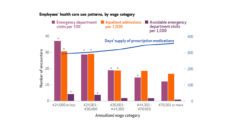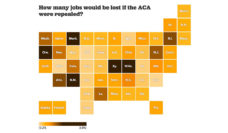The health care sector is now the largest employer in the US, and in many communities, health systems have replaced manufacturers as the largest employer in town. We know that health care organizations provide high quality jobs for workers with advanced degrees, such as physicians, pharmacists, and administrators, but does the health care sector provide “good jobs” for men and women without a college degree?
Jobs in the health care sector for workers without a college degree include direct care occupations like nursing assistants, home health aides, personal care aides, as well as middle-skill occupations that require additional training and more specialized skills, such as surgical technicians, ultrasound technicians, or associate-level registered nurses.
Most occupations within the health care sector that are filled by workers without a college degree are filled primarily by women. In fact, over 25% of women without a college degree are employed in the health care industry. On the other hand, only about 5% of men without a college degree work in the health care sector.
Is the health care sector replacing the “good jobs” that manufacturers have traditionally provided for the working-class? In a recent study published in Social Science Research, my co-author Melissa Hodges and I addressed this question by focusing on four central job quality characteristics: decent wages (especially whether workers make at least $15 per hour), employer-based health insurance, full-time hours, and protection from layoff.
Instead, the growth of the health care sector is contributing to growing economic strain within working-class families, and the health care sector needs to take greater responsibility for promoting the economic wellbeing of working-class families by improving job quality for its lowest earners.
We found that for women without a college degree, the health care sector is more likely to provide “good jobs” as compared to the other two most common alternatives for working-class women: retail and food service. For example, about 25% of working-class women in the health care sector earn at least $15 per hour, as compared about 10% in retail and 5% in food service.
For working-class men, however, the health care sector is not a source of “good jobs,” despite the fact that men have better job quality in the health care sector as compared to women. For example, when we compare men’s wages in health care ($14 per hour) to wages manufacturing and construction, which are around $16 and $17 per hour, respectively, health care falls behind. Given these wage differences, it is not surprising that so few working-class men are working in the health care sector.
That said, the health care sector does provide some advantages for men. Men working in health care were far less likely to be laid off as compared to manufacturing and especially construction, and jobs in the health care sector are also more likely to provide employer-based health insurance as compared to construction. So working-class men face a trade-off: they can earn higher wages in manufacturing and construction, but they will have greater job security and potentially better fringe benefits in the health care sector.
How do health care jobs compare to the manufacturing jobs that they are replacing? The majority of these jobs are filled by women, and for women, health care jobs are “good jobs.” But female-dominated health care jobs don’t replace the wages and job quality provided by manufacturing. Instead, the growth of the health care sector is contributing to growing economic strain within working-class families, and the health care sector needs to take greater responsibility for promoting the economic wellbeing of working-class families by improving job quality for its lowest earners.














